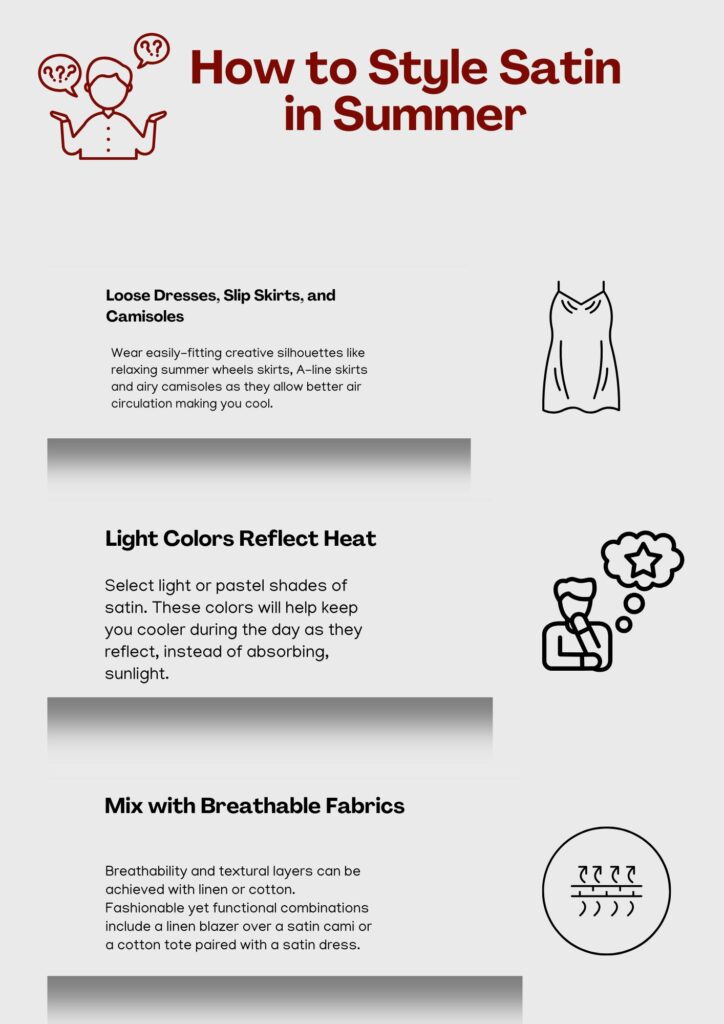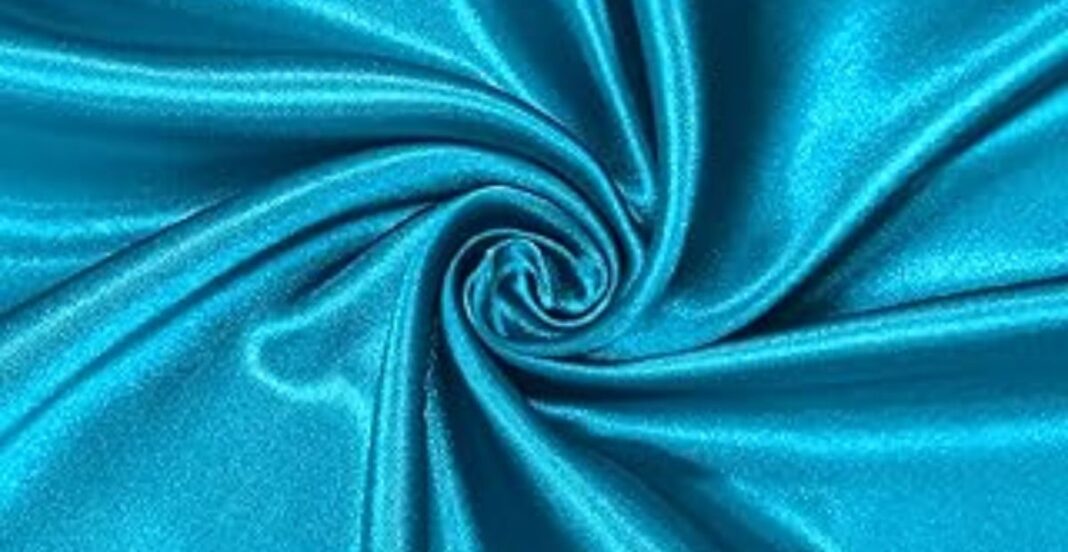Introduction
One of the most timeless and luxurious fabrics in fashion satin has a glossy surface and fluid drape which often appears in high-end pieces and lingerie. Moreover, gowns satin raises a seasonal question:Can You Wear Satin in the Summer?
The warmer months mean that breathable clothing will be essential so many worry if the sleek texture and shine of satin would be better suited for evening attire rather than summer. This article is going to look at whether satin can truly be worn year-round and if it can, how to do it wisely.
To answer this question, let’s review its composition, breathability, advantages and disadvantages, how to style it and more.
What Is Satin? (Brief Overview)
What Is Satin? (Brief Overview)
Satin refers to a weave, not a type of fiber. A satin weave creates a smooth and lustrous surface on one side and leaves the other side dull. Silk, polyester, nylon, acetate or blended fibers can be used to make satin.
Silk satin is luxurious and very breathable while polyester satin is less expensive and more resistant to wrinkles. Regardless of the fiber used, glam occasions always favor the signature shine that satin features.
Satin’s slippery finish along with its soft feel makes it pleasant to touch though breathability will depend on the base fiber. The true nature of breathability is what makes wearing it in summer uncomfortable or not.
Is Satin Breathable in Summer?
Silk Satin vs. Synthetic Satin
Not all satin breathes the same, as some are more appropriate for certain weathers than others. Silk satin is more breathable than synthetic ones, making it easier to maintain a body’s temperature. This makes silk satin more favorable during hot weather.
On the other end of the spectrum, satin made from polyester or nylon is less breathable and tends suffocate heat and sweat. During humid days, wearing these types of garments may be uncomfortable due to their lack of breathability.
Satin vs. Other Summer Fabrics
In comparison to summer favorites like chiffon, linen or cotton, satin takes a middle position. While both cotton and linen provide great moisture absorption alongside breathability, chiffon outdoes them with its lightness and ability to allow air circulation.
Due to the fiber content used in its production, satin can sometimes be heavier and less absorbent gown fabrics such as chiffon. However, in style competition for lightweight evening gowns with silk dresses during summertime events, floaty versions of satin perform exceptionally well—their charm matches that of lighter counterparts but their appearance keeps them winning in style. Hence the answer “yes” seems valid when asking whether one can wear satins in summers if needed—but only if accompanied by stated conditions.
Pros of Wearing Satin in Summer

Lightweight & Comfortable for Evenings
Satin has a natural lightness, especially when made into garments such as slips and skirts. This enables one to remain cool during warm summer evenings while looking stylish.
The fabric’s fluid nature allows it to move over the skin with ease which provides a refreshing experience after sunset for most people.
Moisture-Wicking (In Silk Satin)
In particular, silk satin is well-known for its moisture-wicking abilities. It pulls perspiration from the skin’s surface and dries quickly.
This feature aids in providing comfort during humid summer outings by keeping one feeling dry and fresh.
Elegant and Stylish
Satin has unique charm and light reflecting abilities. As a result, satin fabric is very popular in wedding gowns or for dresses that are worn to dinners and parties as it accentuates beauty.
For summer, putting on something casual turns into an effortless elegant look with the addition of satin which enhances your summer style.
Cons of Wearing Satin in Summer
Synthetic Satin Traps Heat
The use of animal fibers creates satins made from wool which have poor ventilation infusing fibers polyester or nylon as their bases.–Wool satins have low breathability slike ability to retain heat creating a sticky feeling like sweat.
Putting on synthetic satin when there’s high temperarure or too much humidity may result
Static Cling in Humidity
Satin has other downsides, such as its capacity to cling. This problem is accentuated by humid weather, making it much more difficult to maintain the desired appearance of your outfit.
This can be somewhat alleviated either by wearing anti-static looser fitting satin garments.
Requires High Maintenance
Satin has other drawbacks too, like its contraction properties. As I mentioned above, this problem is worsened during hot weather.
If you look at Sugarkids collection carefully you will see that they incorporate some form of anti static within their designs in order to keep everything looking sharp at all times.
Best Types of Satin for Summer
Silk Satin The Most Breathable
Satin silk is the ultimate summer fabric. It maintains breathability, moisture-wicking and is gentle on the skin.
This fiber helps keep your temperature down while effortlessly looking elegant, answering the question “can satin be worn in summers” with a resounding yes.
Charmeuse Satin Lightweight Choice
Charmeuse satin is lightweight, glossy satin made of silk or blended with some synthetics. Its soft drape and lightweight feel makes it ideal for flouncy summer outfits.
If you seek effortless sophistication without bulk, try charmeuse.
Blended Satin with Moisture-Wicking Fabrics
Today, some satins are mixed with rayon or modal to make them more breathable. The comfort and breathability of these blends satin structured summer garments alongside glamor.
Always examine the label when buying summer satin to check if it is blended with natural fabrics or other performance materials.
How to Style Satin in Summer

Loose Dresses, Slip Skirts, and Camisoles
Wear easily-fitting creative silhouettes like relaxing summer wheels skirts, A-line skirts and airy camisoles as they allow better air circulation making you cool.
Tighter styled clothing tends to hold in perspiration which makes one uncomfortable.
Light Colors Reflect Heat
Select light or pastel shades of satin. These colors will help keep you cooler during the day as they reflect, instead of absorbing, sunlight.
Summer-friendly tones include white, beige, blush pink and lavender.
Mix with Breathable Fabrics
Breathability and textural layers can be achieved with linen or cotton. Fashionable yet functional combinations include a linen blazer over a satin cami or a cotton tote paired with a satin dress.
Do not wear all satin ensembles, particularly in brutally hot weather between 12 PM and 3 PM.
Best Satin Outfits for Summer Occasions
Casual Day Outfits
Consider styling satin shorts with either a cotton tank top or swap it with a denim short for a satin cami. These outfits are great for casual brunches and shopping.
Complete the outfit with flat sandals and your favorite sunhat.
Evening Glam
Satin looks best during night time. Wear a satin midi dress or wrap dress for added elegance at dinner dates or sunset weddings.
Accessorize with strappy heels and minimal jewelry so the focus remains on the fabric.
Office-Ready Looks
An example of an outfit for the office would be a satin blouse tucked into wide-leg trousers which is polished and chic. Sneakers with low or closed toe heels, together with a light blazer will complete the look.
Professional attire will be best complemented with neutral shades.
Caring for Satin in Hot Weather
Washing and Drying Tips
The care label should always be checked first. For silk satin, gentle hand washing in cold water is ideal.
While drying silk garments, avoid direct sunlight because they can fade and the fibers can get damaged. It is best to lay them flat to dry.
Preventing Sweat Stains and Odors
Use breathable underwear and underarm shields to circumvent sweat stains. Steer clear of antiperspirants containing aluminum as they may leave marks on the fabric.
Gentle satin seltzers can be used to revitalized satin garments for fabrics throughout the day.
Alternatives to Satin for Summer
Linen and Cotton
Sharply tailored garments made from cool cotton or linen are quite breathable due to moisture wicking and airflow capabilities.
Great when satin becomes too luxurious or heavy in hot condition.
Rayon and Chiffon
Chiffon and rayon are equally light and airy. While chiffon adds a floaty look to garments, rayon imitates silk.
These options work well if you’re wondering can you wear satin in the summer, but prefer something understated.
Conclusion
What about wearing satin during summer? As long as it’s styled properly, summer wear is totally doable.
Stay away from heavy, daytime stiff synthetics they’re a no-go. Opt for silk or blended satin for more breathable daytime options. Wearing light colors and roomy shapes adds elegance too.
Satin works for casual days, work attire and most importantly evenings and especially if paired correctly. To keep looking fabulous and fresh this summer, remember these tips.
FAQs
Block silk satin makes your skin breathe better compared to synthetic satin which traps heat, making you sweat more.
Answering your last question yes is an option but prefer lighter color loose designs combined with breathable ornaments respecting covered arms. Additionally, for comfort avoid using materials like synthetic satin.
For sure! Evening or indoor weddings are best paired with satin dresses or suits.
Pay attention to heat levels and choose the right fabric type.


